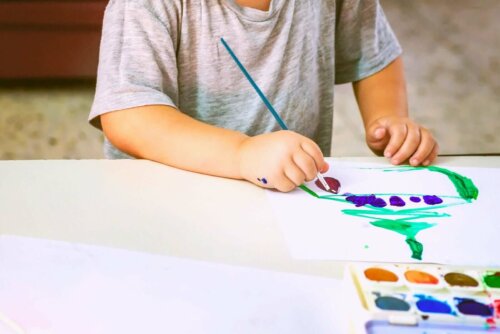How to Analyze Children's Drawings According to the Colors They Use


Written and verified by the psychologist Mara Amor López
Children’s drawings can tell us a lot about their personality, their relationship with their environment, and their emotional management. Here, we’ll explain how to analyze children’s drawings according to the colors they use. Although parents can draw some conclusions, it’s always a good idea for a professional to handle the interpretations of the drawings.
When it comes to interpreting a child’s drawings, it’s important that we pay special attention to all the details. All of this will tell us things about their personality. We must notice the position, size, and details of the drawing, as well as the pressure of the pencils when drawing and even the lines. However, what gives us the most information about their emotional development is the colors that the child uses when painting or drawing.
Do you want to know what the color choices in your child’s drawings mean and what they can say about their personality? Continue reading to find out!
Things to keep in mind when you analyze children’s drawings according to colors
Before starting to see what meaning each color has in children’s drawings, we’re going to see some aspects that must be considered in order to make a correct interpretation.

Take into account other aspects, besides the colors
When we analyze a child’s drawing, we have to contemplate the drawing in a holistic way. This includes all the details, the child’s age, forms of the lines, the intensity of the lines, where the drawings are located on the paper, etc.
It’s not an exact method and there may be errors in the assessment
Despite this, these techniques are very useful, especially with children, since drawing is a simple and fun activity. Through drawing, we can detect if children have certain problems; whereas with other methods it would likely be difficult to get them to express what they feel.
The hypotheses made by child psychologists always have to be verified with another more structured evaluation. The drawing will always be a very necessary complement for making a holistic psychological evaluation of the child.
Color characteristics vary according to shades
Colors that tend more towards a pastel hue or that are applied softly indicate that we’re facing a calmer and more emotional character. While the brighter or more marked colors are related to more intense feelings, which can be negative (aggressiveness) or positive (love).
To analyze children’s drawings, it’s important to see if colors are being used in an ideal way
This refers to how children use colors as they see them in reality, which usually occurs from the age of 7. If a child paints a yellow sun or a green meadow, we can analyze them according to color.
However, if the little one paints the sun green, we have to take into account the reason why they’ve made this change with respect to the corresponding color of the drawing. It may be for drawing attention, a transgression of the rules, creativity, or impulsiveness. It’s something to be analyzed.
Analyze children’s drawings according to colors
Now that we know some of the things to take into account, we can have an afternoon of painting with our children to see if we’re able to get to know them a little more through their drawings. Go for it, but remember that it’s important to keep a lookout for any predominant colors.
Blue
Blue provides a feeling of calm, balance, and tranquility. Introverted and shy children use this color predominantly in their drawings. It can also indicate that a child is thoughtful and sensitive. An excess of the color blue or its intense use may tell us that there’s a problem of enuresis.
Pink
Although it’s common to see the color pink as something exclusive to girls, it’s not the case. Both boys and girls can use color equally and it indicates that we’re dealing with very imaginative children. On occasion, it may point out that the child has a need to flee from reality or has immense creativity.
Green
Much like the color blue, green is an indicator of a calm and sensitive child. If the child uses this color in elements that aren’t green, it tells us that the child may feel like a misfit or rebellious.
Orange
A predominance of this color indicates that we’re dealing with a very sociable child that likes to be in contact with other people. It can also imply that the child is very active and impulsive, and could even have problems with concentrating on a certain task.

Black
Even though black gives most grownups a feeling of sadness, in this case, it indicates power and elegance. Children that use this color are perfectionists, though they may also be a bit introverted and distant from others.
Brown
This is a popular color used among prudent and responsible children. If it’s used in excess, we have to make sure the child isn’t missing out on childhood experiences as a result of an exaggerated sense of responsibility.
Yellow
Yellow is a color that tells us that we’re dealing with a very social and happy child. When there’s too much yellow, it can mean there’s some tension and emotional distress.
Red
This is a very common color used by boys, probably for its intensity. If it’s used in a moderate way, it denotes that the child is passionate and has a lot of energy. However, if there’s too much red, it could indicate that there are aggression problems, a lack of balance, and hostility.
Purple
This color is related to melancholy, so its excessive use signals there may be feelings of dissatisfaction in the child. If this is the case, we should address this as soon as possible.
How to analyze children’s drawings according to colors
As you’ve already seen, analyzing children’s drawings according to colors can tell us a lot about their emotional world, their personality, and whether they may be going through a problem that needs immediate attention.
However, this information only helps us for orienting ourselves and learning more about our kids. It never replaces a professional psychological assessment. A licensed psychologist will be the one to conduct an exhaustive analysis of the child and tell us with certainty if there is a problem or not.
But in the meantime, let’s draw!
Children’s drawings can tell us a lot about their personality, their relationship with their environment, and their emotional management. Here, we’ll explain how to analyze children’s drawings according to the colors they use. Although parents can draw some conclusions, it’s always a good idea for a professional to handle the interpretations of the drawings.
When it comes to interpreting a child’s drawings, it’s important that we pay special attention to all the details. All of this will tell us things about their personality. We must notice the position, size, and details of the drawing, as well as the pressure of the pencils when drawing and even the lines. However, what gives us the most information about their emotional development is the colors that the child uses when painting or drawing.
Do you want to know what the color choices in your child’s drawings mean and what they can say about their personality? Continue reading to find out!
Things to keep in mind when you analyze children’s drawings according to colors
Before starting to see what meaning each color has in children’s drawings, we’re going to see some aspects that must be considered in order to make a correct interpretation.

Take into account other aspects, besides the colors
When we analyze a child’s drawing, we have to contemplate the drawing in a holistic way. This includes all the details, the child’s age, forms of the lines, the intensity of the lines, where the drawings are located on the paper, etc.
It’s not an exact method and there may be errors in the assessment
Despite this, these techniques are very useful, especially with children, since drawing is a simple and fun activity. Through drawing, we can detect if children have certain problems; whereas with other methods it would likely be difficult to get them to express what they feel.
The hypotheses made by child psychologists always have to be verified with another more structured evaluation. The drawing will always be a very necessary complement for making a holistic psychological evaluation of the child.
Color characteristics vary according to shades
Colors that tend more towards a pastel hue or that are applied softly indicate that we’re facing a calmer and more emotional character. While the brighter or more marked colors are related to more intense feelings, which can be negative (aggressiveness) or positive (love).
To analyze children’s drawings, it’s important to see if colors are being used in an ideal way
This refers to how children use colors as they see them in reality, which usually occurs from the age of 7. If a child paints a yellow sun or a green meadow, we can analyze them according to color.
However, if the little one paints the sun green, we have to take into account the reason why they’ve made this change with respect to the corresponding color of the drawing. It may be for drawing attention, a transgression of the rules, creativity, or impulsiveness. It’s something to be analyzed.
Analyze children’s drawings according to colors
Now that we know some of the things to take into account, we can have an afternoon of painting with our children to see if we’re able to get to know them a little more through their drawings. Go for it, but remember that it’s important to keep a lookout for any predominant colors.
Blue
Blue provides a feeling of calm, balance, and tranquility. Introverted and shy children use this color predominantly in their drawings. It can also indicate that a child is thoughtful and sensitive. An excess of the color blue or its intense use may tell us that there’s a problem of enuresis.
Pink
Although it’s common to see the color pink as something exclusive to girls, it’s not the case. Both boys and girls can use color equally and it indicates that we’re dealing with very imaginative children. On occasion, it may point out that the child has a need to flee from reality or has immense creativity.
Green
Much like the color blue, green is an indicator of a calm and sensitive child. If the child uses this color in elements that aren’t green, it tells us that the child may feel like a misfit or rebellious.
Orange
A predominance of this color indicates that we’re dealing with a very sociable child that likes to be in contact with other people. It can also imply that the child is very active and impulsive, and could even have problems with concentrating on a certain task.

Black
Even though black gives most grownups a feeling of sadness, in this case, it indicates power and elegance. Children that use this color are perfectionists, though they may also be a bit introverted and distant from others.
Brown
This is a popular color used among prudent and responsible children. If it’s used in excess, we have to make sure the child isn’t missing out on childhood experiences as a result of an exaggerated sense of responsibility.
Yellow
Yellow is a color that tells us that we’re dealing with a very social and happy child. When there’s too much yellow, it can mean there’s some tension and emotional distress.
Red
This is a very common color used by boys, probably for its intensity. If it’s used in a moderate way, it denotes that the child is passionate and has a lot of energy. However, if there’s too much red, it could indicate that there are aggression problems, a lack of balance, and hostility.
Purple
This color is related to melancholy, so its excessive use signals there may be feelings of dissatisfaction in the child. If this is the case, we should address this as soon as possible.
How to analyze children’s drawings according to colors
As you’ve already seen, analyzing children’s drawings according to colors can tell us a lot about their emotional world, their personality, and whether they may be going through a problem that needs immediate attention.
However, this information only helps us for orienting ourselves and learning more about our kids. It never replaces a professional psychological assessment. A licensed psychologist will be the one to conduct an exhaustive analysis of the child and tell us with certainty if there is a problem or not.
But in the meantime, let’s draw!
All cited sources were thoroughly reviewed by our team to ensure their quality, reliability, currency, and validity. The bibliography of this article was considered reliable and of academic or scientific accuracy.
- Pont Amenos, T. (2014).Los test gráficos en el psicodiágnostico. Madrid: Sintesis.
This text is provided for informational purposes only and does not replace consultation with a professional. If in doubt, consult your specialist.








